MARK BANDO'S WEBSITE
Page 6 War Stories
The Historian's Mission: Get the Facts Straight
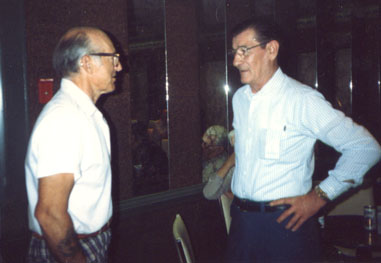 When reading various accounts of the surrender of the 1st battalion, 6th Para Rgt at Hells Corners, I discovered (as a much younger researcher), that each account described a different cast of characters going out under fire, to bring-in the German major who commanded that unit.
When reading various accounts of the surrender of the 1st battalion, 6th Para Rgt at Hells Corners, I discovered (as a much younger researcher), that each account described a different cast of characters going out under fire, to bring-in the German major who commanded that unit.
Check the accounts in 'Night Drop' by SLA Marshall, 'Rendezvous With Destiny', by Rapport and Northwood, and 'Four Stars of Hell', by Critchell. In some accounts, Nicholai and Blanchette accompanied Colonel Johnson onto the field. In others, Leo F. Runge went out with William F.('Fritz') Lenz. Even for a fledgling researcher, these discrepancies raised red flags back in the 1970s.
I had the privilege to meet Leo Runge in 1973, at the Houston reunion (and I fell heir to his Silver Star Medal after his death in the early 1990s), whose version appears in my 'Vanguard' book. Nicholai, a 'Incredible Patrol' survivor and one of Col. Johnson's bodyguards, was arrested by the British in 1948, smuggling arms to the Israelis, during their war for independence. He has not been heard of since. Norman Blanchette died in an ambush, outside Bastogne in December, 1944.
Over the course of my investigations, I met a man who in 1944, had written a lengthly official statement about what he saw at the time of the Hells Corners surrender. He gave me a copy of his statement in 1978 and he swore at that time, that the contents were true. About 8 years later, he told me that the official statement he had written, was a pack of lies, and that a certain commander had dictated the contents of that statement, (as this trooper typed it), under coercion. Experiences like this, make it difficult to say the least, for a researcher to uncover the true story.
The photo above was taken by the webmaster in 1984, at a 501st PIRA reunion. I had just introduced William F. Lenz (SvCo/501) and Leo F. Runge(HQ/501) and they were meeting for the first time. So much for historical accounts.
Solving Another Historical Mystery
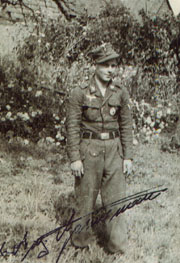 Some in the academic fraternity have called me a dirty name, i.e.:"Revisionist", because the info uncovered by my research sometimes contradicts the'official' versions or else what was written soon after the events took place.
Here's another example: Heinz Gonnermann is a German parachutist and veteran of the Ramcke Brigade, which fought in N. Africa and the Meditteranean Theatre. I've met him at a couple of Snowbird reunions, and he now resides in the U.S. He gave me the above photo of his brother,
Some in the academic fraternity have called me a dirty name, i.e.:"Revisionist", because the info uncovered by my research sometimes contradicts the'official' versions or else what was written soon after the events took place.
Here's another example: Heinz Gonnermann is a German parachutist and veteran of the Ramcke Brigade, which fought in N. Africa and the Meditteranean Theatre. I've met him at a couple of Snowbird reunions, and he now resides in the U.S. He gave me the above photo of his brother,
August Gonnermann
who now resides in Canada. August was an engineer in the 15th Kompanie of Para Rgt 6 at Carentan, in June, 1944. August says he and his comrades from the 15th Kp personally placed explosives, wired and demolished
bridge (#2) over the Douve River, on the Carentan Causeway, on 8 June, 1944. There has always been debate in American circles, as to who and how the bridge was destroyed. Frank Carpenter of C/501 always claimed that he was beside Lt. Farrell, the naval fire spotter, near la Barquette, and saw and heard him call for fire on Bridge #2 from the 14" guns of Battleship Texas. I so-stated in my 'Vanguard' book. We now have rather compelling evidence that German parachutists actually blew that bridge up, on 8 June. Those of you who have read 'Night Drop', or seen the S.C. sound interview with LTC Robert G. Cole of 3/502, know that a rope and plank bridge was improvised at the spot where Bridge #2 was blown, to facilitate crossing of the 3/502 on 10 June, 1944. Visitors to that bridge now, will find that both bridges #1 and #2 have been rebuilt in slightly different places, as a method of straightening out the Causeway. Thanks to Heniz Gonnermann for providing the wartime photo of his brother, in Fallschirmjager uniform.
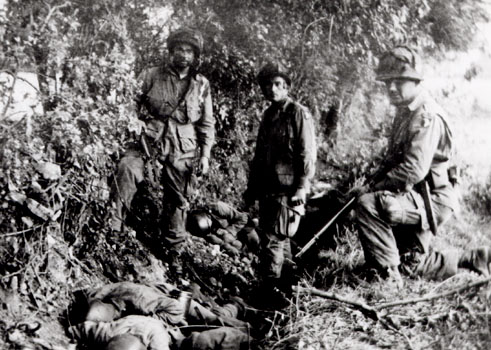 In the Normandy photo above, Joe Pistone, Floyd Baker (a medic) and Mike Milenczenko of F/502 view German artillerymen killed in a one man charge by Ben Shaub, who was later KIA in Holland.
In the Normandy photo above, Joe Pistone, Floyd Baker (a medic) and Mike Milenczenko of F/502 view German artillerymen killed in a one man charge by Ben Shaub, who was later KIA in Holland.
Not every trooper who wore the screaming eagle patch was a killer.
A radioman from HQ/3 501 recently told me he went through Normandy, Holland, Bastogne, and So. Germany without ever firing his carbine in combat. Job clasifications were not necessarily an indicator of who would kill. For example, Joe Mero, a clerk typist in HQ/2 501 shot many Germans from his roost in a grain elevator at Veghel, Holland on 23 September, 1944. Joe was fatally wounded the following day. Being scattered behind enemy lines meant that any individual might be called upon by circumstances to kill or be killed.
Certainly, troopers who hunted the enemy day and night like McMorries were the exception. But even beyond that, some have suggested that many
rifle company paratroopers ended WW2 without knowing for certain if they had killed a single German. In Normandy, troopers most
often fired at bushes or hedgerows where they thought German troops were concealed. Later, when moving up, they saw German bodies but usually didn't know whose bullets had killed them.
Likewise, in a battle on open terrain, where enemy troops were visible, many troopers were firing at them simultaneously, again making it difficult or impossible to determine whose bullets struck them. Leo Gillis of F/501 used to claim that a relative handful of men in each company did 90% of the killing. Just as
on a baseball team, there are the home run hitters, so in an Army company, there are a few individuals who excel at killing the enemy. (They usually aren't the same men who excel at baseball).
Army historian S.L.A. Marshall stirred up a great controversy soon after WW2, when he released his book "Men Against Fire". After interviewing hundreds of combat riflemen, both from the Army and Marines, Marshall concluded that only 25%, or one man in four, even fired his weapon during a battle. Many American WW2 combat vets have vehemently disputed that figure. But Army Brass took it seriously enough to revise recruit training in the late 1940's. During the war in Korea, the percentage of soldiers who fired allegedly increased significantly due to this revised training. "Men Against Fire" was reprinted by the University of Oklahoma Press in 2000. For those interested in reading Marshall's opinions, it is available again, for the first time in many years.
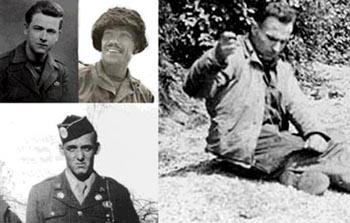 Something to consider:
The paratroopers pictured above belonged to F company, 501 PIR.
In the Normandy campaign, these four men inflicted about 100 casualties on the German military. Clockwise, from upper left, Leo Gillis shot 16 Germans on D-Day alone, by his own count. He took out more as the campaign progressed, including a number of
SS troopers on 13 June. Although numbers are unavailable, Joe Bass was among the top scoring killers in F company until he was grazed in the head by a bullet on 13 June, 1944. He returned to fight in the other campaigns and survived WW2. But Bass was KIA in Korea, September, 1950, while fighting with the 27th Infantry Regiment ('Wolfhounds'). Bass was generally considered the
best combat soldier in F company. He is buried at Arlington National Cemetery.
Something to consider:
The paratroopers pictured above belonged to F company, 501 PIR.
In the Normandy campaign, these four men inflicted about 100 casualties on the German military. Clockwise, from upper left, Leo Gillis shot 16 Germans on D-Day alone, by his own count. He took out more as the campaign progressed, including a number of
SS troopers on 13 June. Although numbers are unavailable, Joe Bass was among the top scoring killers in F company until he was grazed in the head by a bullet on 13 June, 1944. He returned to fight in the other campaigns and survived WW2. But Bass was KIA in Korea, September, 1950, while fighting with the 27th Infantry Regiment ('Wolfhounds'). Bass was generally considered the
best combat soldier in F company. He is buried at Arlington National Cemetery.
Stanley "Pappy" Green was 33 years old in 1944, but was a crackerjack machinegunner. On two seperate days, he shot over 30 Germans with his M1919A-4 light
machine-gun. Green didn't like the disorganization of paratroopers entering combat. In Normandy, it seemed they didn't have a plan of battle. He requested and received a transfer to the regular infantry after surviving Normandy. Nobody in F company questioned his skill or courage. His eventual fate after leaving the 501 is unknown at this time.
John Penta joined F company's third platoon late in 1943 and was never fully accepted by members of the 3rd platoon. Slightly misdropped in Normandy, he roamed around, lost, with Sgt Kent McKenney for the first several days. When the duo rejoined the company on June 9th, McKenney told the others "This Penta is a real Tiger! He killed about 25 Germans with his 'grease gun'
(M-3) in the last three days." Penta was killed in battle by grenadiers of the 17th SS Division on 13 June, 1944.
More insights from 'Tex' McMorries, who wrote after the war:"In the terminology of the men of the 101st Airborne, the highest regards extended to a living man was :'he is a Real Trooper'. (His actions were in accord with the highest traditions of the military service.) There was no terminology:'Above & Beyond the call of duty', the usual words used to describe War Heroes. The 101st Airborne had so many 'Real Troopers', but no Heroes. Somewhere along the line, they forgot to inform the men that anything was above and beyond the call of duty. Although many stories have been filmed and told, the true great war stories will perhaps remain unwritten and unfilmed, because it would be so savage and ruthless that no one would dare film it. Some of the men led such a fearless existence that nothing was surprising. Most of the men wanted to make one independent patrol with me, but few wanted a second."
Webmaster's note: Tex kept a journal during Market-Garden, in which he recorded kills with his knife (usually on patrols). He
had seventeen such entries when the campaign ended. He also wrote: "Few men have lived the toughest parts of war. (for example)-being discovered by civilians while on patrol behind enemy lines, a soldier, right or wrong, does what he has to do, not to jeopardize the safety of the patrol."
Contributions of Gliderborne Troops
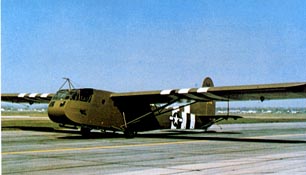 A CG-4A American-made WACO glider, restored to WW2 configuration, including Invasion Stripes, courtesy the Silent Wings museum, Terrell, Texas. Invasion craft flying over naval forces had been shot down by friendly fire at Sicily. Thereafter, these black and white stripes were painted onto the wings and lower fuselages of gliders and C-47's, in hopes of preventing a repetition of similar mishaps.
A CG-4A American-made WACO glider, restored to WW2 configuration, including Invasion Stripes, courtesy the Silent Wings museum, Terrell, Texas. Invasion craft flying over naval forces had been shot down by friendly fire at Sicily. Thereafter, these black and white stripes were painted onto the wings and lower fuselages of gliders and C-47's, in hopes of preventing a repetition of similar mishaps.
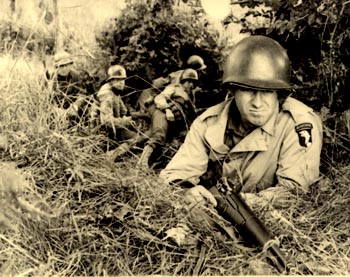 Glider Infantrymen from the 327/401 also saw heavy fighting.
Like those pictured above, they wore regular infantry garb in
the field. Note the Type 5 white tongued subvariant patch on the man in the foreground.
Glider Infantrymen from the 327/401 also saw heavy fighting.
Like those pictured above, they wore regular infantry garb in
the field. Note the Type 5 white tongued subvariant patch on the man in the foreground.
101st Glider Landings in Normandy
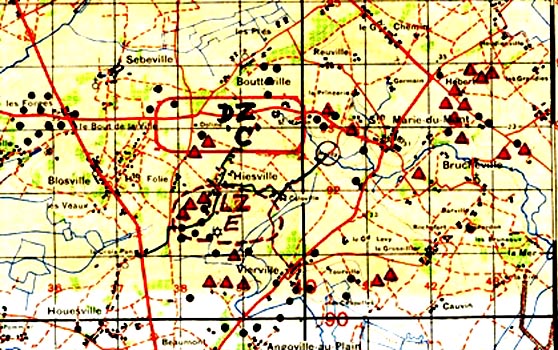 The small black dots indicate landing locations of the 52 CG-4A WACO gliders of the'Chicago Mission', which landed 148 men at 0400 hrs on D-Day. The Red Triangles indicate landing locations of the 'Keokuk mission'. This consisted of 32 Horsa gliders, which delivered 165 men, including 6 A.T. guns of the 327th GIR at 2130 hrs on 6 June, 1944. Not shown is a WACO which strayed south and landed off this map below Carentan The
markings were made on a 1:50,000 map entitled'La Haye du Puits'
using map overlays from the effects of LTC Ben Weisberg of the 377th PFA Bn. These gliders were all carrying 101st Airborne personnel and had a fairly concentrated landing pattern compared to the jumpers, although many gliders smashed into hedgerows.
due to a limted number of suitable Landing zones (LZ's) in France, as well as a finite number of gliders and trained pilots, the bulk of 101st glider troops (the 327th GIR with 401 attached), were brought to Normandy by sea. The only sub unit of the 101st which sent a significant portion of its men to Normandy by Glider was the 81st AT/AA Bn. Their Battery 'A' was attached to 506th PIR, and Battery'B' also came in on CG-4As at 0400AM, in the Chicago Mission landings. With them came a total of 16 British 6 pounder (57mm) anti tank guns and their crews, plus eleven jeeps and two trailers of ammunition. The Anti Tank gun platoon of H&H/327th GIR, landed on D-Day evening via British Horsa gliders in the Keokuk Mission, bringing-in their 37mm anti tank guns.
The small black dots indicate landing locations of the 52 CG-4A WACO gliders of the'Chicago Mission', which landed 148 men at 0400 hrs on D-Day. The Red Triangles indicate landing locations of the 'Keokuk mission'. This consisted of 32 Horsa gliders, which delivered 165 men, including 6 A.T. guns of the 327th GIR at 2130 hrs on 6 June, 1944. Not shown is a WACO which strayed south and landed off this map below Carentan The
markings were made on a 1:50,000 map entitled'La Haye du Puits'
using map overlays from the effects of LTC Ben Weisberg of the 377th PFA Bn. These gliders were all carrying 101st Airborne personnel and had a fairly concentrated landing pattern compared to the jumpers, although many gliders smashed into hedgerows.
due to a limted number of suitable Landing zones (LZ's) in France, as well as a finite number of gliders and trained pilots, the bulk of 101st glider troops (the 327th GIR with 401 attached), were brought to Normandy by sea. The only sub unit of the 101st which sent a significant portion of its men to Normandy by Glider was the 81st AT/AA Bn. Their Battery 'A' was attached to 506th PIR, and Battery'B' also came in on CG-4As at 0400AM, in the Chicago Mission landings. With them came a total of 16 British 6 pounder (57mm) anti tank guns and their crews, plus eleven jeeps and two trailers of ammunition. The Anti Tank gun platoon of H&H/327th GIR, landed on D-Day evening via British Horsa gliders in the Keokuk Mission, bringing-in their 37mm anti tank guns.
81st Anti-Tank Crew at VeghelOn Saturday, 23 September, 1944, a 6 pounder anti tank gun of the 81st Airborne AT/AA Bn swung into action on the outskirts of Veghel. In concert with troops of the 401 Glider Infantry, they brought a Panther tank under fire and knocked it out. Walter Cronkite posted a news column on the incident, which, as you will see, was improvised in the confusion of battle. The quick actions of the AT gun crew reopened Hell's Highway, and possibly saved many American lives.
LTC XB Cox Jr, the Commanding Officer of the 81st Bn at the time, has written a brief narrative which explains how this happened.:
(On 23 September, 1944), Division advance headquarters was in a large house on the south side of Veghel Holland. For some reason, I was there and I was present in the room when the call came in that the road north of Veghel had been cut, and a German tank was in the battle. General McAuliffe turned to me and said "Go see what the report is all about."
I left the building, which was some hundred feet from the main road. As I reached the road, one of my jeeps, towing a 57mm AT gun was passing. Captain A.G. Gueymard, Pvt Rogie Rogers, and a driver were in the jeep. I jumped on the jeep and told them that we needed to get to the north side of town.
The road was narrow, and British trucks were stopped bumper to bumper, and many of their soldiers were out of their vehicles. It was difficult to weave our way through the
village. About halfway through the village, a Lt. who was standing in a doorway asked if we needed some help. I said "Get on", and he did.
We reached the north edge of the village, where some British trucks were on fire. Much rifle fire was occurring. I think that some 327th GIR men were on the left side of the road and some 506 PIR men were on the right side. We could hear the sounds of a tank up the road, so we unhitched the AT gun from the jeep, and spread the trails on the tarmac. Just then, the tank came into view, coming down the road toward us, probably 200 yards distant.
The tank turned to it's right and left the road, going into a field. By that time, the gun was ready, so Roberts fired and hit the tank in the side and it burst into flames. The crew started coming out and I suppose the 327 men finished them off. When our gun fired, the gun recoil broke Roberts' knee, so Gueymard, who had sighted the gun on the first shot, moved over and fired two more rounds. All three hit the tank.
At the time, I thought the tank had fired before we did, because brick from the building behind us fell around us. However, they might have been brought down by the concussion of our anti tank gun.
I went over to the 506 area and attempted to get the rifle firing stopped. In a short time all became quiet and I walked back to the advance division headquarters and told General McAuliffe that we had stopped the tank and the road was open. It had all happened in about 35-40 minutes.
In 1951 at our reunion in Detroit, General McAuliffe told my wife Melba the details of this tank episode and enjoyed telling the story. Colonel Sherburne was sitting at the table with me.
The division history 'Rendezvous With Destiny' says the 327th claimed the tank kill, but the holes in the side of the tank were not 37mm shell holes.
The Lt. who got on the jeep and helped handle the ammunition tracked me down some 25 years later. I knew that he had been a glider pilot, but did not know his name. He was Lt Tom Berry and he attended our reunion in Chicago in 1982.
I didn't give Cronkite details of this action, but I did have occasion to visit with him at other times.
Col. XB Cox Jr. 6 November, 2001.
Note from the webmaster: The 506th troops who took part in this action are believed to have been members of Company F. Lt Bob 'Jack Rabbit'Perdue of that company was involved, and is trying to nail down the precise location where this happened. He also thinks that the 327th troops across the road were actually members of the 401 Glider Infantry-M.B.
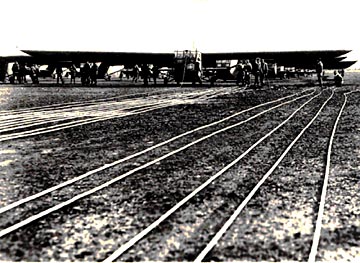
WACO gliders with tow ropes laid out on the runway at Greenham Common airfield in 1944. c/o Cecil L. Simmons.
Medics of the 326th AMC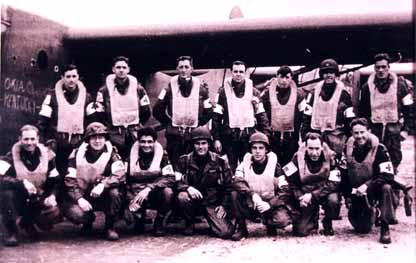 Pictured above are medics of the 326th Airborne Medical Company before departing for Holland in September, 1944. standing l. to r.: first 2 unknown, Earl Stewart, Captain Roy H. Moore, unk., Captain Edwin C. Yeary, unk. Below, l. to r.: Ernest T, Lakeman, Miles H. Jenkins, Sam Amico, Keath Bickle, Joe Makar,
Ed A. Miller, and Abraham "Joe" Nidle. Many of these men became POWs when the 101st division hospital was captured at Bastogne. This photo with names, courtesy Sam Amico, who also identified men in some of the photos in my new book.
Pictured above are medics of the 326th Airborne Medical Company before departing for Holland in September, 1944. standing l. to r.: first 2 unknown, Earl Stewart, Captain Roy H. Moore, unk., Captain Edwin C. Yeary, unk. Below, l. to r.: Ernest T, Lakeman, Miles H. Jenkins, Sam Amico, Keath Bickle, Joe Makar,
Ed A. Miller, and Abraham "Joe" Nidle. Many of these men became POWs when the 101st division hospital was captured at Bastogne. This photo with names, courtesy Sam Amico, who also identified men in some of the photos in my new book.
-all images and information on War Stories pages Copyright
Mark Bando, September, 2000-
Under Construction














